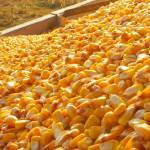Using Corn in Horse Feeds

Corn is the leading crop in America in terms of volume and value. It is a major cereal grain used in horse feeds. As with most cereal grains, corn is used primarily for its energy, and thus its carbohydrate components are usually considered to be most important. Starch is found mainly in the endosperm, comprising 70 to 72% of the corn kernel. The type of starch may be horny or floury, depending on variety. The starch in dent corn, the type normally used for feed, is approximately 74% amylopectin or branched glucose and 26% amylose, or long chain glucose. These starch granules are readily available to enzymatic digestion by amylases and amyloglucosidases.
Corn is considered to be low in protein, generally averaging 8 to 10%. Because of the high incorporation rate in feeds, however, substantial amounts of protein are supplied by corn. Corn protein is especially deficient in lysine, having a level of about 0.25% as opposed to 0.40% for oats and barley, 0.6% for wheat mill run, and 3.1% for soybean meal.
Corn used in the feed industry should have a test weight of 52 lb (24 kg) per bushel. Maximum foreign material is 4%. The maximum level of damaged kernels is 7%. Maximum moisture is 16%. Color should be bright to golden yellow, and no moldy, sour, or musty smell should exist.
Grains are routinely stored for long periods of time, and thus the quality factors often revolve around proper storage conditions and the adverse effects resulting from improper storage. In general, particular attention must be paid to moisture and temperature. Microbe growth is minimized when grains are stored at less than 13% moisture. Corn is normally harvested at 22 to 28% moisture to maximize efficiency of harvesting and reduce the number of broken kernels.
Corn must be dried for proper storage. Corn dried at temperatures greater than 140° F. often becomes cracked or damaged, making it more susceptible to insect or microbial damage. Corn that is stored too wet may begin to mold, and in some extreme instances may heat up enough to cause severe damage to the kernels.
Moldy or musty-smelling corn should not be used in horse feed. If a moldy or musty odor can be detected, the corn has been severely damaged, since changes take place long before the odor is noticeable. If mold is present, it is almost certain that toxins have been produced. These toxins are, for the most part, very heat stable and even if the feed is pelleted or extruded, the toxins will not be destroyed.








